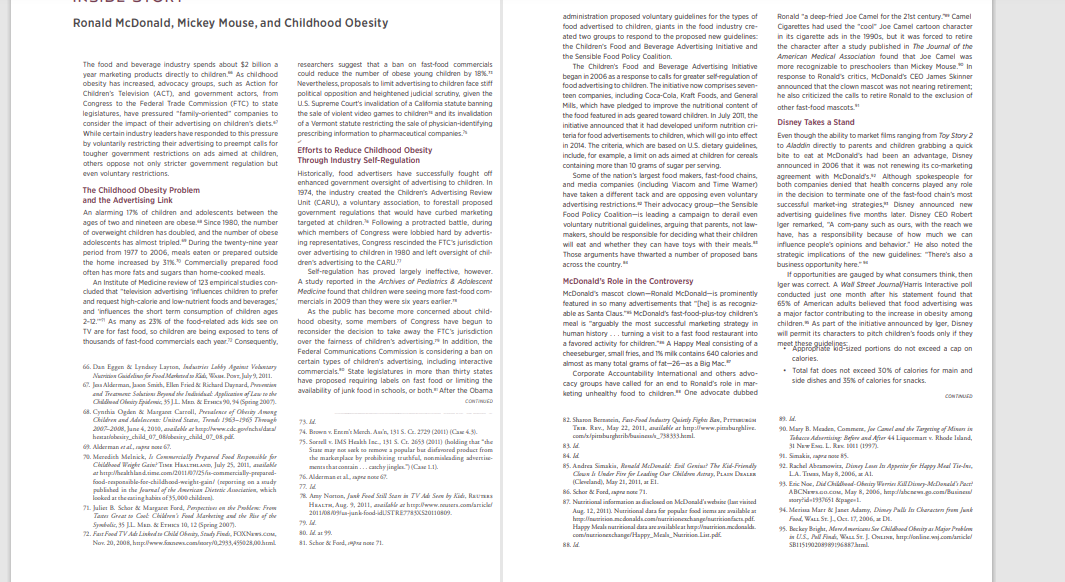Question
Consider the possible conflicts between legally doing business and selling fast food, given the increasing evidence of how it is a significant contributing factor in
Consider the possible conflicts between legally doing business and selling fast food, given the increasing evidence of how it is a significant contributing factor in public health, obesity, and diabetes facing many Americans. Now, based on what you've learned in this module, answer the following:
A) What ethical obligations, if any, do fast food companies have to consumers?
B) Does government (federal, state, or local) have a right or a responsibility to get involved in this conflict? If so, what and to what limit? If not, why not?
Provide sound reasoning for your stance and back it up with references from your book or other sources, if possible. Your logic should be factual, not emotional. Rely on IRAC as you craft your posts, so you address the scenario from a legal analysis perspective. However, your posts do not need to structure as formally as your other writing


Ronald McDonald, Mickey Mouse, and Childhood Obesity The food and beverage industry spends about $2 billion a year marketing products directly to children." As childhood obesity has increased, advocacy groups, such as Action for Children's Television (ACT), and government actors, from Congress to the Federal Trade Commission (FTC) to state legislatures, have pressured "family-oriented" companies to consider the impact of their advertising on children's diets. While certain industry leaders have responded to this pressure by voluntarily restricting their advertising to preempt calls for tougher government restrictions on ads aimed at children, others oppose not only stricter government regulation but even voluntary restrictions. The Childhood Obesity Problem and the Advertising Link An alarming 17% of children and adolescents between the ages of two and nineteen are obese." Since 1980, the number of overweight children has doubled, and the number of obese adolescents has almost tripled." During the twenty-nine year period from 1977 to 2006, meals eaten or prepared outside the home increased by 31% Commercially prepared food often has more fats and sugars than home-cooked meals. An Institute of Medicine review of 123 empirical studies con- cluded that "television advertising influences children to prefer and request high-calorie and low-nutrient foods and beverages," and 'influences the short term consumption of children ages 2-12. As many as 23% of the food-related ads kids see on TV are for fast food, so children are being exposed to tens of thousands of fast-food commercials each year. Consequently. 66. Dan Eggen & Lyndsey Layton, Industries Lobby Against Voluntary Nutrition Guidelines for Food Marketed to Kids, Wesse. Por, July 9, 2011. 67. Jess Alderman, Jason Smith, Ellen Fried & Richard Daynard P and Treatment Solutions Beyond the Individual: Application of Law to the Child Obesity Epidemic, 35 JL. Man & Erics 90, 94 (Spring 2007). 68. Cynthia Ogden & Margan Carroll, Prevalence of Obesity Among Children and Adolescent: United States, Trends 1963-1965 Through 2007-2008, June 4, 2000, available at hmpo//www.cdc.gov/nchs/das/ beat/obesity child_07_08/obesity_child_07_08.pdf 69. Alderman et al, 67 70. Meredith Melnick, Is Commercially Prepared Food Responsible for Childhood Wright Gain? TIME HEALTHLAND, July 25, 2011, available at http://healthland.time.com/2011/07/25-commercially-prepared food-responsible-fee-childhood-weight-gain/ (porting on a study published in the Journal of the American Dietetic Association, which looked at the eating habits of 35,000 children). 71. Juliet B. Schor & Margar Ford, Perspectives on the Problem: From Tastes Great to Cool: Children's Food Marketing and the Rise of the Symbolic, 35 J.L. Man. & Erics 10, 12 (Spring 2007). 72. Fast Food TV Ads Linked to Child Obesity, Study Finds,FOXNews.com Nov. 20, 2008, http://www.foxnews.com/nary/0,2933,455028,00.html researchers suggest that a ban on fast-food commercials could reduce the number of obese young children by 18%.** Nevertheless, proposals to limit advertising to children face stiff political opposition and heightened judicial scrutiny, given the U.S. Supreme Court's invalidation of a California statute banning the sale of violent video games to children" and its invalidation of a Vermont statute restricting the sale of physician-identifying prescribing information to pharmaceutical companies." Efforts to Reduce Childhood Obesity Through Industry Self-Regulation Historically, food advertisers have successfully fought off enhanced government oversight of advertising to children. In 1974, the industry created the Children's Advertising Review Unit (CARU), a voluntary association, to forestall proposed government regulations that would have curbed marketing targeted at children. Following a protracted battle, during which members of Congress were lobbied hard by advertis- ing representatives, Congress rescinded the FTC's jurisdiction over advertising to children in 1980 and left oversight of chill- dren's advertising to the CARU." Self-regulation has proved largely ineffective, however. A study reported in the Archives of Pediatrics & Adolescent Medicine found that children were seeing more fast-food com- mercials in 2009 than they were six years earlier." As the public has become more concerned about child- hood obesity, some members of Congress have begun to reconsider the decision to take away the FTC's jurisdiction over the fairness of children's advertising." In addition, the Federal Communications Commission is considering a ban on certain types of children's advertising, including interactive commercials. State legislatures in more than thirty states have proposed requiring labels on fast food or limiting the availability of junk food in schools, or both." After the Obama CONTINUED 73.ld. 74. Brown v. Enem's Merch. Au'n, 131 S. Ct. 2729 (2011) (4.3). 75. Sorrell v. IMS Health Inc., 131 S. Ct. 2653 (2011) (holding that "the State may not seek to remove a popular but disfavored product from the marketplace by prohibiting truthful, nonmisleading advertise ments that contain...caschy jingles.) (Case 1.1). 76. Alderman et al., 77. Id 67. 78. Amy Nanton, Junk Food Still Sean in TV Ads Seen by Kids, Ruma HEALTH, Aug. 9, 2011, available at http://www.nuters.com/article 2011/08/09/-junk-food-idUSTRE7783520110809. 79.d 80.99 81. Schoe & Fond, administration proposed voluntary guidelines for the types of food advertised to children, giants in the food industry cre- ated two groups to respond to the proposed new guidelines: the Children's Food and Beverage Advertising Initiative and the Sensible Food Policy Coalition. The Children's Food and Beverage Advertising Initiative began in 2006 as a response to calls for greater self-regulation of food advertising to children. The initiative now comprises seven- teen companies, including Coca-Cola, Kraft Foods, and General Mills, which have pledged to improve the nutritional content of the food featured in ads geared toward children. In July 2011, the initiative announced that it had developed uniform nutrition cri- teria for food advertisements to children, which will go into effect in 2014. The criteria, which are based on U.S. dietary guidelines, include, for example, a limit on ads aimed at children for cereals containing more than 10 grams of sugar per serving. Some of the nation's largest food makers, fast-food chains, and media companies (including Viacom and Time Wamer) have taken a different tack and are opposing even voluntary advertising restrictions. Their advocacy group-the Sensible Food Policy Coalition-is leading a campaign to derail even voluntary nutritional guidelines, arguing that parents, not law- makers, should be responsible for deciding what their children will eat and whether they can have toys with their meals." Those arguments have thwarted a number of proposed bans across the country." McDonald's Role in the Controversy McDonald's mascot clown-Ronald McDonald-is prominently featured in so many advertisements that "[he] is as recogniz able as Santa Claus." McDonald's fast-food-plus-toy children's meal is "arguably the most successful marketing strategy in human history... turning a visit to a fast food restaurant into a favored activity for children.*** A Happy Meal consisting of a cheeseburger, small fries, and 1% milk contains 640 calories and almost as many total grams of fat-26-as a Big Mac. Corporate Accountability International and others advo- cacy groups have called for an end to Ronald's role in mar- keting unhealthy food to children." One advocate dubbed 82. Sharon Bernein, Fat-Food Industry Quietly Figh T. Rev., May 22, 2011, available at http://www.pittburghline. com/x/pimburgherib/business 738333.html. 83. Id 84. Id 85. Andrea Simakis, Ronald McDonald: Evil Genius? The Kid-Friendly Clowns Under Fire for Leading Our Children ALDER (Cleveland), May 21, 2011, ar El. 86. Schor & F &Ford, 71. 87. Nutritional information as disclosed on McDonald's website (last visited Aug. 12, 2011). Nutritional data for popular food items are available at http:/nutrition mcdonalds.com/nutritionexchange/nutritionfacts.pdf. Happy Meals nutritional data are available at hponition.mcdonalds com/nutionexchange/Happy Meals Nutrition Lin.pdf 88. Id. Ronald "a deep-fried Joe Camel for the 21st century." Camel Cigarettes had used the "cool" Joe Camel cartoon character in its cigarette ads in the 1990s, but it was forced to retire the character after a study published in The Journal of the American Medical Association found that Joe Camel was more recognizable to preschoolers than Mickey Mouse." In response to Ronald's critics, McDonald's CEO James Skinner announced that the clown mascot was not nearing retirement; he also criticized the calls to retire Ronald to the exclusion of other fast-food mascots." Disney Takes a Stand Even though the ability to market films ranging from Toy Story 2 to Aladdin directly to parents and children grabbing a quick bite to eat at McDonald's had been an advantage, Disney announced in 2006 that it was not renewing its co-marketing agreement with McDonald's. Although spokespeople for both companies denied that health concerns played any role in the decision to terminate one of the fast-food chain's most successful market-ing strategies, Disney announced new advertising guidelines five months later. Disney CEO Robert Iger remarked, "A com-pany such as ours, with the reach we have, has a responsibility because of how much we can influence people's opinions and behavior." He also noted the strategic implications of the new guidelines: "There's also a business opportunity here."" If opportunities are gauged by what consumers think, then Iger was correct. A Wall Street Journal/Harris Interactive poll conducted just one month after his statement found that 65% of American adults believed that food advertising was a major factor contributing to the increase in obesity among children. As part of the initiative announced by Iger, Disney will permit its characters to pitch children's foods only if they meet these guidelines Appropriate kid-sized portions do not exceed a cap on calories. Total fat does not exceed 30% of calories for main and side dishes and 35% of calories for snacks. 89. Id. CONTINUED 90. Mary B. Meaden, Commer, Joe Camel and the Targeting of Minar in Tobacco Advertising: Before and After 44 Liquorman v. Rhode Island, 31 New E. L. Rex 1011 (1997) 91. Simki, 85 92. Rachel Abramowitz, Disney Loves It Appetite for Happy Meal Tie-Ins, LA. T, May 8, 2006, Al. 93. Eric Noe, DidChildhood-Obesity Worries Kill Disney-McDonald's Pact! ABCNEW.GO.COM, May 8, 2006, hmp://abcnews.go.com/Busines story?id=1937651&pages. 94. Merina Marr & Janet Adamy, Dimry Pulls In Character from Junk Food, WALL ST. J., Oct. 17, 2006, Dt. 95. Beckey Bright, More Americans See Childhood Obesity as Major Problem in US, Pall Finds, WALL ST. J. ONLINE, ponline.wsj.com/article/ SB115190208989196887himl
Step by Step Solution
There are 3 Steps involved in it
Step: 1
A Ethical Obligations of Fast Food Companies Fast food companies have a moral obligation to prioritize consumer health and wellbeing The increasing ev...
Get Instant Access to Expert-Tailored Solutions
See step-by-step solutions with expert insights and AI powered tools for academic success
Step: 2

Step: 3

Ace Your Homework with AI
Get the answers you need in no time with our AI-driven, step-by-step assistance
Get Started


